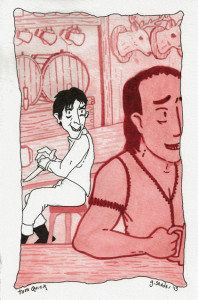Recently I have been reading a book called Blue Hills and Shoefly Pies written by Ann Hark in 1952. The tales from its pages predate the publication by at least 12 years. In the book she travels and visits with people, putting together a compelling book of tales. The tales range from a hunt to determine the cryptic writings on a magic mirror (including instructions on making your own, which I may do a piece on later) to the ordinary, every day (visits with neighbors and outdoor picnic lunches). The places she cites are places I have been occasionally and places I frequent. And, while some places, such as Lancaster City’s Southern Market are no longer around, the library still is. While on a journey to the library Miss Hark came across an account of a monstrous figure in Pennsylvania history and lore.
Thomas Quick Jr. lived in Pike County which is close to Carbondale in Pennsylvania. (Pike county shares a bank with Lake Wallenpaupack, perhaps you’ve heard of it, it’s mentioned in this episode of the office. He grew up in a time where there were few other white settlers. He was friends with the Native Americans and learned many of their forestry skills from them. In time more settlers arrived, and with them came strained relationships with the Native residents. Attacks on white settlers became more frequent and Tom fell out of touch with his former friends. One day, as he and his father were crossing a frozen lake they were ambushed. Tom was shot in the leg and limped to the bank, his father, however, was shot and then scalped alive in front of Tom’s eyes. At that point Tom swore to slay 100 indians as the sole goal of his life. One evening, as he sulked in a tavern, he met a native fellow. As they talked and the drinks flowed, Tom realized that this fellow belonged to the party that slayed the elder Tom. Not only that, the man proudly proclaimed it when he realized he was talking to the younger Tom. So Tom murdered him. And he didn’t stop there, accounts say that Tom didn’t exclude anyone from his warpath, murdering women, children, and families all together. And so Tom became a monster, a terror, and a hero to be admired, depending on who you were to ask. Tom’s story, as it turns out, ends one of two ways, with him on his death bed, beseeching his friend to bring an elderly Indian that he knew lived nearby so that he could complete his goal. His friend was quite reluctant to do so, and in some versions he didn’t, leaving Tom one murder short of his 100. In other versions he completes his grisly task and dies shortly after with a content look on his face.
(Illustrator’s Corner) I debated doing a piece about this monstrous fellow, but ultimately I decided to do it. certainly, I didn’t restrain myself from making him look wretched, (I imagine even monsters feel the toll of murdering families). But I thought it interesting and potentially still relevant. We live in times that are rife where various groups of people have tenuous relationships (immigration anyone?) And, while, thank God we have enough order that a grisly task like murdering 100 people is not tolerated, that hate and desire to do harm can still linger. It is still possible to hate 100 people relentlessly. It’s not much, and I’m a nobody of an illustrator, but illustration (and art) addresses people, that’s why it exists. I made this piece because of that.
~Greg
